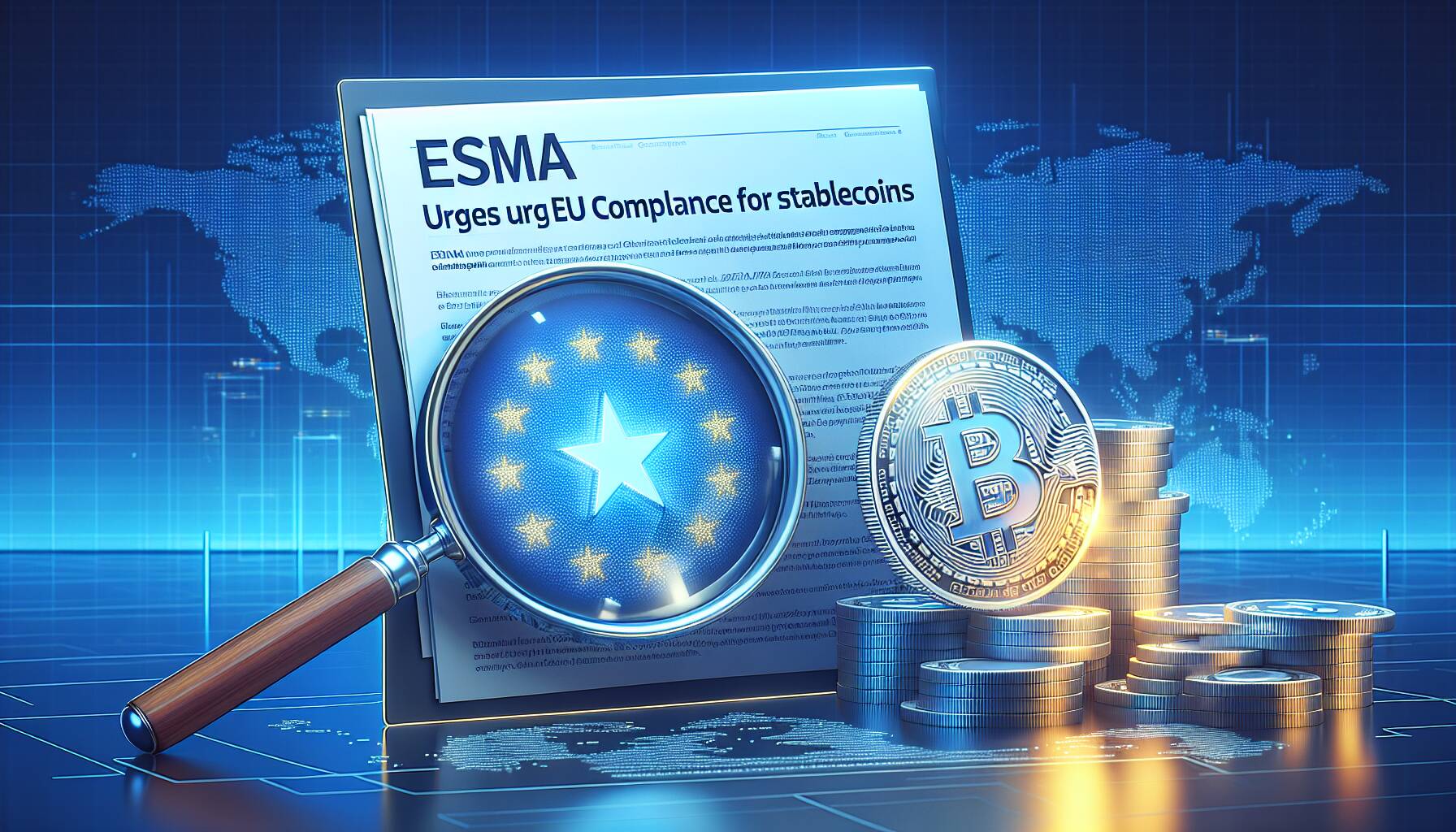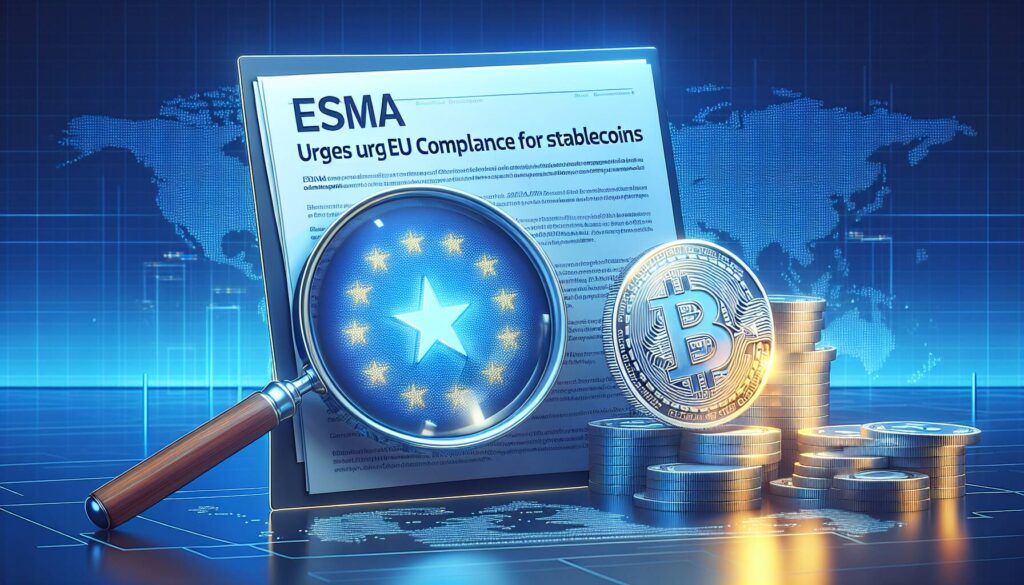The European Securities and Markets Authority (ESMA) has issued an urgent call to national authorities across the European Union, signifying a pivotal moment for the cryptocurrency landscape. In a statement released on Friday, ESMA has urged the 27 EU member states to ensure that cryptocurrency asset service providers (CASPs) cease trading non-compliant stablecoins within the next two months, as part of a broader move to enhance regulatory compliance amidst ongoing scrutiny of cryptocurrency practices.
Stablecoins, digital currencies pegged to assets, are at the heart of this regulation, which targets those that do not adhere to the new Market in Crypto-Assets (MiCA) guidelines. ESMA’s directive specifically addresses asset-referenced tokens (ARTs) and electronic money tokens (EMTs), warning that non-compliant variants, including prominent players like Tether’s USDT, could face restrictions that would significantly impact their availability to EU clients. The compliance deadline for stablecoin issuers is set for the end of the first quarter in 2025, prompting many in the industry to scramble for compliance.
“In practice, this means CASPs operating a trading platform for crypto-assets are expected to stop making all crypto-assets that would qualify as ARTs and EMTs but for which the issuer is not authorized in the EU available for trading,” ESMA noted.
This proactive approach from ESMA reflects the growing trend of regulatory authorities stepping up their scrutiny of the crypto market, with large issuers like Tether already taking action. Just last November, Tether announced the discontinuation of its euro stablecoin, EURT, while struggling to secure an e-money license for EU operations. In contrast, Circle has successfully obtained such a license earlier this year.
Exchanges that are registered in the EU, such as Gemini and Coinbase, will also be impacted. Coinbase has already indicated its commitment to compliance, noting that it would delist any stablecoins failing to meet the MiCA requirements by December 2024. A spokesperson for Coinbase confirmed that the company is in the process of restricting services related to non-compliant stablecoins, while expressing optimism about re-enabling services once compliance is achieved.
As the clock ticks down to the compliance deadlines, the future of stablecoin trading in the European Union hangs in the balance, with both the market and regulators keeping a close eye on developments. This could very well set the stage for transformative changes in how stablecoins operate within one of the world’s largest economic regions.

ESMA’s Urgent Call for Stablecoin Compliance in the EU
The European Securities and Markets Authority (ESMA) has issued an important directive impacting how stablecoins are regulated and traded in the EU. Here are the key points from this development:
- Compliance Deadline: National authorities in the EU must ensure that non-compliant stablecoins are no longer available for trading within two months.
- Classifications of Tokens: The directive refers to two types of tokens:
- ARTs: Asset Referenced Tokens
- EMTs: Electronic Money Tokens
- Impact on Non-Compliant Stablecoins: Stablecoins that do not meet EU regulations, such as Tether’s USDT, will be affected if they are offered to EU clients.
- Issuer Compliance: Issuers like Tether and Circle are seeking compliance, with Circle successfully obtaining an e-money license while Tether has not.
- Exchange Requirements: Crypto asset service providers (CASPs), such as Coinbase and Gemini, are required to delist non-compliant stablecoins.
- Future of Services: Exchanges like Coinbase have already indicated a commitment to restrict services related to non-compliant stablecoins, with potential for reinstating services in the future.
“Given our commitment to compliance, we restricted the provision of services to Retail, Exchange, and Prime Vault customers… in connection with stablecoins that do not meet the MiCA requirements.” – Coinbase Spokesperson
This regulatory action by ESMA signifies a critical shift in the landscape of cryptocurrency trading in the EU. Readers in the EU involved with crypto investments or services might need to:
- Stay informed about which stablecoins will remain compliant and available for trading.
- Consider the implications for their investment strategies, especially regarding non-compliant assets.
- Monitor changes and updates in regulations that could impact their trading practices and compliance requirements.
ESMA’s Mandate on Stablecoins: The Impacts of Compliance in the EU Market
The recent call to action by the European Securities and Markets Authority (ESMA) underscores significant changes on the horizon for crypto asset service providers (CASPs) operating within the EU. By mandating that non-compliant stablecoins be phased out from trading platforms in the next two months, ESMA aims to tighten regulations around crypto assets, potentially transforming the entire landscape of digital finance in the region.
Comparative Advantages and Disadvantages: The urgency of this ESMA directive offers a competitive edge to compliant players like Circle, which recently secured an e-money license, enabling it to operate smoothly in the EU. This proactive approach not only enhances stakeholder trust but also positions Circle as a leader in regulatory adherence. Conversely, the inability of entities like Tether to obtain necessary licenses could disenfranchise their existing user base in the EU, potentially leading to a loss in market share and customer loyalty.
Furthermore, exchanges such as Coinbase and Gemini will face significant operational challenges. While their commitment to following the MiCA framework enhances their reputation, they risk losing users who favor the more versatile offerings of non-compliant stablecoins. This is a double-edged sword: regulatory adherence strengthens regulatory relationships, but it could alienate traders who are keen on diverse trading options.
As these regulations unfold, the implications are clear—issuers struggling to meet compliance standards could find their market accessibility severely limited. Those who fail to adapt may face a diminishing presence in a rapidly evolving financial landscape. However, compliant platforms could seize new opportunities for engagement and establish stronger footholds, potentially attracting a more risk-averse and regulatory-conscious clientele.
Target Audience: The strict regulations could significantly benefit investors and stakeholders looking for safer avenues in the crypto market, as they prefer platforms that exhibit clear compliance with EU laws. However, for everyday traders used to the flexibility offered by non-compliant options, this shift might pose challenges. Thus, as the regulatory landscape grows more formidable, the stakes are higher for all involved, making it essential for stakeholders to remain informed and adaptable.

















